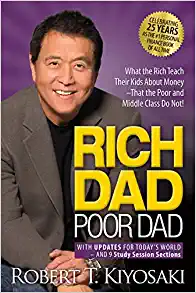Robert Kiyosaki’s “Rich Dad Poor Dad” is a financial education book presenting a unique wealth-building perspective. The book has sold millions of copies worldwide and has become a must-read for anyone interested in personal finance.
Kiyosaki engages readers with a storytelling approach that makes “Rich Dad Poor Dad” an easy and captivating read. Through his personal experiences, he contrasts his biological father’s financially unstable life as an educated man with his friend’s father, an uneducated but successful entrepreneur, and investor, whom he sees as his rich dad.
Kiyosaki uses the contrast between his two father figures to introduce readers to financial literacy – the ability to manage money effectively. He believes that traditional education neglects to teach us how to become financially literate, instead promoting the idea of working for money rather than learning how to make money work for us.
Kiyosaki breaks down the book into ten chapters, each examining different aspects of financial literacy. He introduces numerous unconventional ideas, such as emphasizing the significance of investing in assets that generate passive income, such as real estate or stocks, rather than solely relying on a paycheck from a job.
One of the book’s most memorable lessons is the concept of the “cash flow quadrant,” which divides people into four categories: employees, self-employed, business owners, and investors. Kiyosaki argues that in order to become financially free, one must strive to move from the left side of the quadrant (employee and self-employed) to the right side (business owner and investor).
Kiyosaki also stresses the importance of developing financial intelligence, which involves understanding financial statements, knowing the difference between an asset and a liability, and being able to evaluate investment opportunities. He advocates for taking calculated risks and learning from failures, rather than playing it safe and sticking to a traditional job.
While Kiyosaki’s ideas may be unconventional, they have resonated with many readers, especially those who are tired of the rat race of working for a paycheck. However, some critics have accused Kiyosaki of oversimplifying complex financial concepts and promoting a get-rich-quick mentality.
Moreover, some readers may take issue with Kiyosaki’s emphasis on self-employment and entrepreneurship, which may not be feasible or desirable for everyone. Additionally, the book’s portrayal of his “poor dad” as a well-educated but financially struggling person has been criticized for perpetuating negative stereotypes about those with traditional jobs.
Overall, “Rich Dad Poor Dad” is a thought-provoking and engaging read that challenges traditional notions about money and encourages readers to develop financial literacy. While some of Kiyosaki’s ideas may not be universally applicable or accepted, the book remains valuable for those interested in achieving financial freedom and success.
